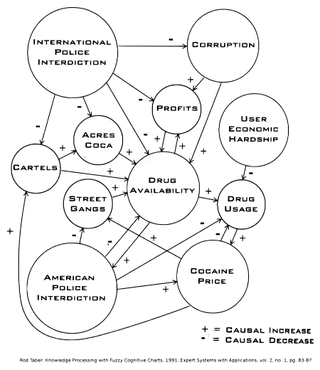Related Research Articles
In computational intelligence (CI), an evolutionary algorithm (EA) is a subset of evolutionary computation, a generic population-based metaheuristic optimization algorithm. An EA uses mechanisms inspired by biological evolution, such as reproduction, mutation, recombination, and selection. Candidate solutions to the optimization problem play the role of individuals in a population, and the fitness function determines the quality of the solutions. Evolution of the population then takes place after the repeated application of the above operators.
Friendly artificial intelligence is hypothetical artificial general intelligence (AGI) that would have a positive (benign) effect on humanity or at least align with human interests or contribute to fostering the improvement of the human species. It is a part of the ethics of artificial intelligence and is closely related to machine ethics. While machine ethics is concerned with how an artificially intelligent agent should behave, friendly artificial intelligence research is focused on how to practically bring about this behavior and ensuring it is adequately constrained.
Neuroevolution, or neuro-evolution, is a form of artificial intelligence that uses evolutionary algorithms to generate artificial neural networks (ANN), parameters, and rules. It is most commonly applied in artificial life, general game playing and evolutionary robotics. The main benefit is that neuroevolution can be applied more widely than supervised learning algorithms, which require a syllabus of correct input-output pairs. In contrast, neuroevolution requires only a measure of a network's performance at a task. For example, the outcome of a game can be easily measured without providing labeled examples of desired strategies. Neuroevolution is commonly used as part of the reinforcement learning paradigm, and it can be contrasted with conventional deep learning techniques that use backpropagation with a fixed topology.

Swarm intelligence (SI) is the collective behavior of decentralized, self-organized systems, natural or artificial. The concept is employed in work on artificial intelligence. The expression was introduced by Gerardo Beni and Jing Wang in 1989, in the context of cellular robotic systems.

A multi-agent system is a computerized system composed of multiple interacting intelligent agents. Multi-agent systems can solve problems that are difficult or impossible for an individual agent or a monolithic system to solve. Intelligence may include methodic, functional, procedural approaches, algorithmic search or reinforcement learning.
The expression computational intelligence (CI) usually refers to the ability of a computer to learn a specific task from data or experimental observation. Even though it is commonly considered a synonym of soft computing, there is still no commonly accepted definition of computational intelligence.

James Alexander Hendler is an artificial intelligence researcher at Rensselaer Polytechnic Institute, United States, and one of the originators of the Semantic Web. He is a Fellow of the National Academy of Public Administration.
Evolving classification functions (ECF), evolving classifier functions or evolving classifiers are used for classifying and clustering in the field of machine learning and artificial intelligence, typically employed for data stream mining tasks in dynamic and changing environments.

A fuzzy cognitive map (FCM) is a cognitive map within which the relations between the elements of a "mental landscape" can be used to compute the "strength of impact" of these elements. Fuzzy cognitive maps were introduced by Bart Kosko. Robert Axelrod introduced cognitive maps as a formal way of representing social scientific knowledge and modeling decision making in social and political systems, then brought in the computation.
Artificial intelligence (AI) has been used in applications throughout industry and academia. Similar to electricity or computers, AI serves as a general-purpose technology that has numerous applications. Its applications span language translation, image recognition, decision-making, credit scoring, e-commerce and various other domains. AI which accommodates such technologies as machines being equipped perceive, understand, act and learning a scientific discipline.
Artificial psychology (AP) has had multiple meanings dating back to 19th century, with recent usage related to artificial intelligence (AI).
The AI effect occurs when onlookers discount the behavior of an artificial intelligence program as not "real" intelligence.
An adaptive neuro-fuzzy inference system or adaptive network-based fuzzy inference system (ANFIS) is a kind of artificial neural network that is based on Takagi–Sugeno fuzzy inference system. The technique was developed in the early 1990s. Since it integrates both neural networks and fuzzy logic principles, it has potential to capture the benefits of both in a single framework.
Machine ethics is a part of the ethics of artificial intelligence concerned with adding or ensuring moral behaviors of man-made machines that use artificial intelligence, otherwise known as artificial intelligent agents. Machine ethics differs from other ethical fields related to engineering and technology. It should not be confused with computer ethics, which focuses on human use of computers. It should also be distinguished from the philosophy of technology, which concerns itself with technology's grander social effects.
The Mexican International Conference on Artificial Intelligence (MICAI) is the name of an annual conference covering all areas of Artificial Intelligence (AI), held in Mexico. The first MICAI conference was held in 2000. The conference is attended every year by about two hundred of AI researchers and PhD students and 500−1000 local graduate students.

A social machine is an environment comprising humans and technology interacting and producing outputs or action which would not be possible without both parties present. It can also be regarded as a machine, in which specific tasks are performed by human participants, whose interaction is mediated by an infrastructure. The growth of social machines has been greatly enabled by technologies such as the Internet, the smartphone, social media and the World Wide Web, by connecting people in new ways.
Longbing Cao is an AI and data science researcher at the University of Technology Sydney, Australia. His broad research interest involves artificial intelligence, data science, behavior informatics, and their enterprise applications.
This glossary of artificial intelligence is a list of definitions of terms and concepts relevant to the study of artificial intelligence, its sub-disciplines, and related fields. Related glossaries include Glossary of computer science, Glossary of robotics, and Glossary of machine vision.

Ujjwal Maulik is an Indian Computer Scientist and a Professor. He is the former Head of the Department of Computer Science and Engineering at Jadavpur University, Kolkata, West Bengal, India. He has worked in many countries including India, US, Germany, France, Australia, China, Italy, Poland, Mexico, Slovenia and Hungary. He also held the position of the principal-in-charge and the head of the Department of Computer Science and Engineering at Kalyani Government Engineering College.
References
- ↑ "Intelligent Decision Making: An AI-Based Approach". Studies in Computational Intelligence. Vol. 97. Springer. 2008. doi:10.1007/978-3-540-76829-6. ISBN 978-3-540-76828-9. ISSN 1860-949X.
- ↑ Suarez, Juan Francisco (2014). "Wise by Design: A Wisdom-Based Framework for Innovation and Organizational Design and its Potential Application in the Future of Higher Education". Dissertations & Theses Antioch University: 131.
- ↑ Wang, Feng-Hsu (2011). "Personalized recommendation for web-based learning based on ant colony optimization with segmented-goal and meta-control strategies". 2011 IEEE International Conference on Fuzzy Systems (FUZZ-IEEE 2011). pp. 2054–2059. doi:10.1109/FUZZY.2011.6007628. ISBN 978-1-4244-7315-1. S2CID 33702266.
- ↑ Karamjit, Gill (2013). "Citizens and netizens: a contemplation on ubiquitous technology". AI & Society. 28 (2): 131–132. doi: 10.1007/s00146-013-0451-5 .
- ↑ Molnar, Louis (2014). "A Step Beyond AI: Artificial Philosophy". Frontiers in Artificial Intelligence and Applications (10): 131–132. doi: 10.13140/2.1.1124.6085 .